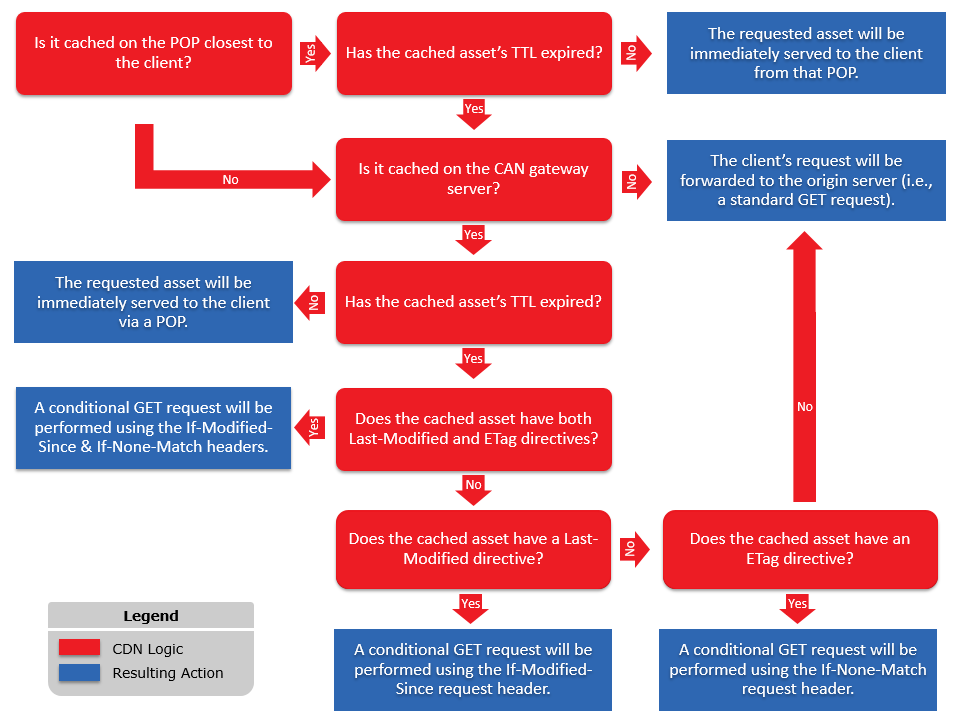|
|
An edge server will immediately serve the requested content to the HTTP client. |
|
|
An edge server will perform either a standard or conditional GET request to the CAN gateway server depending on whether the cached asset contains and/or directives.
-
If the CAN gateway server has it in cache and it is fresh, then it will serve the cached version to the client via the edge server.
- If the CAN gateway server has it in cache and it is stale, then it will perform either a standard or conditional GET request to the origin server depending on whether the cached asset contains and/or directives.
- If the CAN gateway server does not have a cached version of it, then it will perform a standard GET request to the origin server.
 View additional information. View additional information.
-
An edge server will request the content from the CAN gateway server. The type of request that will be submitted is determined by whether the asset cached on the edge server contains a and/or directive.
- Last-Modified and ETag: A conditional GET request will be performed using the and headers.
- Last-Modified: A conditional GET request will be performed using the header.
- ETag: A conditional GET request will be performed using the header.
- Missing Directives: A standard GET request will be performed.
-
The CAN gateway server determines how to handle the request according to the cache state of the requested content.
-
If the asset has been assigned a must-re-validate directive, then one of the following actions will take place:
- If the CAN gateway server can communicate with the origin server, then it will either use a conditional or a standard GET request (as described above).
- If the CAN gateway server cannot communicate with the origin server, then a 504 Gateway Timeout will be returned to the client.
|
|
|
- An edge server will forward the HTTP client's request to the CAN gateway server.
-
The CAN gateway server determines how to handle the request according to the cache state of the requested content.
- Fresh Content: The CAN gateway server will respond with the cached version of the content to the user via an edge server. Skip to step 4.
-
Stale Content & Retrieval: The CAN gateway server will request a new version from the origin server when the following conditions are met:
- An cached version of the requested content is found.
- It has not been assigned either a or directive.
-
Stale Content & Revalidation: The CAN gateway server will with the origin server when the following conditions are met:
- An cached version of the requested content is found.
- It has been assigned either a or directive.
| Revalidation Result |
Description |
|
Match
|
The following actions will take place when the cached version matches the version stored on the origin server:
- The response headers for the asset cached on a CAN gateway server will be updated to reflect a new TTL.
- The asset will be served to the requester via the edge server from step 1.
|
|
Outdated
|
If the cached version is older than the version stored on the customer origin server, then the following actions will take place:
- The new version of the asset will be retrieved from the customer origin server.
- The asset will be served to the requester via the edge server from step 1.
|
|
Not Found
|
If the requested content is not found on the origin server, then a 404 Not Found will be returned to the requester.
|
|
Unknown
|
If a CAN gateway server is unable to establish a connection with the origin server, then a stale version of the requested content may be served. Stale content may be served when both of the following conditions are true:
- The or headers were not assigned to the cached version of the requested content.
- The header was assigned to the requested content and the max-stale time period has not expired.
Learn more.
|
- Not Cached: The CAN gateway server will forward the request to the origin server.
-
The requested content is served to the HTTP client through the following path:
Origin server  CAN CAN gateway server  Edge server  HTTP client
An edge server and the HTTP client will cache eligible requests. If the CAN gateway server requested the content from the origin server, then it will also cache the requested content.
Learn more.
|
